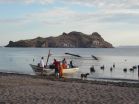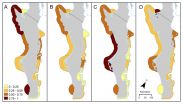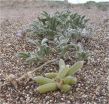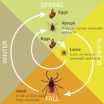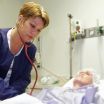(Press-News.org) PROVIDENCE, R.I. [Brown University] -- In 2009, the year she won the Nobel Prize for economics, Elinor Ostrom proposed a framework to integrate both the institutional and ecological dimensions of a pervasive global challenge: achieving sustainability. Now researchers have put Ostrom's social-ecological systems theory into practice in the Mexican state of Baja California Sur. The result is a map of regional strengths and weaknesses that can help guide fishers, conservationists, and other decision makers as they consider steps to preserve the peninsula's vital coastal marine ecosystems.
Those ecosystems are vital to sustaining fisheries that provide food and income. The value of Ostrom's SES framework is that it encourages researchers to consider both natural and human values, said Heather Leslie, the Peggy and Henry D. Sharpe Assistant Professor of Environmental Studies and Biology at Brown University.
"Using this framework enabled us to integrate many different types of data related to coupled human-environment systems," said Leslie, first author of the study in the Proceedings of the National Academy of Sciences. "We were able to be more comprehensive in our analysis than we would have if we had focused only on the data closest to our individual disciplines."
Leslie and her team -- anthropologists, economists, ecologists, fisheries scientists, geographers, and other social scientists -- gathered data on 13 social and ecological variables for each of 12 regions around Baja California Sur. They developed a profile of sustainability potential for each region along the four dimensions laid out in Ostrom's SES framework: governance systems and actors (the social) and resource units and resource systems (the ecological). What became clear is that each region's profile is quite different, suggesting that the most effective policies for achieving sustainability will be ones tailored to shore up each area's weaknesses without undermining its strengths, the authors wrote.
Magdalena Bay and Todos Santos
Take, for example, stories about the Pacific coast regions of Magadalena Bay and Todos Santos, illustrated by the researchers' maps. If Baja California Sur is a leg, then Magdalena Bay is the knee and Todos Santos is the front of the ankle.
In Magdalena Bay, fisheries are diverse and productive. But the area is also crowded with fishers who use many different kinds of gear and do not necessarily follow the same locally developed rules, Leslie said. While the ecological foundation for sustainability looks good there, the social dimensions are considerably less promising.
"Depending on which type of data one musters regarding the potential for sustainable fisheries, Magdalena Bay could be scored as either well-endowed or quite weak," wrote the research team, which also included co-corresponding author Xavier Basurto of Duke University and Octavio Aburto-Oropeza of the University of California-San Diego.
Meanwhile in Todos Santos, local fishery management institutions are quite strong. There is considerable cooperation and compliance among fishers, based on the social science surveys the authors conducted, but the nearshore ocean is less productive and yields fewer species than Magdalena Bay, just 150 miles north. The team's work reveals that, while they are not far apart geographically, the regions are polar opposites in their social and ecological profiles.
In Magdalena Bay, the most productive strategy might be to cultivate stronger local institutions, Leslie said, but in Todos Santos, maintaining local institutional strength and bolstering capacity in the water might make more sense. Leslie cautions however that in most cases, people have considerably less influence over ecosystem dynamics than themselves.
Are there fundamental trade-offs?
The fine-grained diversity of regional strengths and weaknesses apparent in the maps is borne out statistically. The researchers looked for correlations among the four dimensions across Baja California Sur and found few.
The rarity of reliable relationships between strength in one dimension and strength in another was a surprise. It's a result that merits more scrutiny, Leslie said, because while it could reveal a shortcoming of the analysis -- this is among the first attempts to apply the SES in a comparative, quantitative manner -- it might instead reveal something more insidious: a fundamental difficulty for regions to be strong across the board.
"Does something like this represent fundamental trade-offs?" Leslie asked. "What we found suggests that. There is no place that does well in every dimension."
INFORMATION:
The paper's other authors are Mateja Nenadovic, Leila Sievanen, Kyle C. Cavanaugh, Juan José Cota-Nieto, Brad Erisman, Elena Finkbeiner, Gustavo Hinojosa-Arango, Marcia Moreno-Báez, Sriniketh Nagavarapu, Sheila M. W. Reddy, Alexandra Sánchez-Rodríguez, Katherine Siegel, José Juan Ulibarria-Valenzuela, and Amy Hudson Weaver.
The U.S. National Science Foundation (grant: GEO 1114964), the David and Lucile Packard Foundation, Brown University's Environmental Change Initiative and Voss Environmental Fellowship Program, the Walton Family Foundation, and the World Wildlife Fund Fuller Fellowship Program supported the research.
Reported emissions of a group of potent greenhouse gases from developed countries are shown to be largely accurate, but for the wrong reasons, according to new findings from an international team, led by researchers at the University of Bristol,UK.
Until now, there has been little verification of the reported emissions of hydrofluorocarbons (HFCs), gases that are used in refrigerators and air conditioners, resulting in an unexplained gap between the amount reported, and the rise in concentrations seen in the atmosphere. This new study shows that this gap can be almost ...
The ocean has been sucking up heat-trapping carbon dioxide (CO2) building up in our atmosphere--with a little help from tiny plankton. Like plants on land, these plankton convert CO2 into organic carbon via photosynthesis. But unlike land plants that are held fast to terra firma, plankton can sink into the deep ocean, carrying carbon with them. Along the way they decompose when bacteria convert their remains back into CO2.
It's called the "biological pump," and if it operated 100 percent efficiently, nearly every atom of carbon drawn into the ocean would be converted ...
A Simon Fraser University researcher has uncovered what may be the first quantified evidence demonstrating a relationship between upright locomotion and spinal health.
Scientists have long pondered whether there is a link between walking upright and back problems, since people have more back pain than other primates such as chimpanzees, with whom we share 98 per cent of our DNA.
Kimberly Plomp, a post-doctoral fellow and biological anthropologist, spent the past seven years studying ancient bones for the telltale signs of disease and injury that give archaeologists ...
Beginning in the 1880s, coastal dunes in the United States were planted with European beachgrass (Ammophila arenaria) in an attempt to hold the sand in place and prevent it from migrating. The grass did the job it was brought in to do. As it trapped sand in its deep roots, the dunes at the beachfront grew higher and steeper and less sand moved inland. But, like many attempts to control nature, this one had unintended consequences.
Although dunes may look barren, they are actually reservoirs of biodiversity. "If you're a plant lover, the sand dunes are just spectacular," ...
(Millbrook, NY) The month of May brings many things, among them Mother's Day, tulips, and Lyme Disease Awareness campaigns. But according to Dr. Richard S. Ostfeld, a disease ecologist at the Cary Institute of Ecosystem Studies in Millbrook, NY, if we want to get a leg up on tick-borne illness we need to become vigilant earlier in the season.
In New York State, the blacklegged ticks that carry Lyme disease and other pathogens are already active in late April. Ostfeld explains: "For more than two decades, we've been monitoring tick activity in the Hudson Valley region ...
KNOXVILLE--The monk parakeets that have invaded Europe and North America over the last 40-50 years fortifying their massive communal nests atop utility poles in many urban areas appear to have originated from the same small area in South America, according to a new study.
Considered one of the best speaking parrots, thousands of these bright green birds have been imported for the pet trade, and feral populations began appearing in the United States in the 1960s and in Europe in the 1980s. And yet, these two independent invasions--in the United States and in Europe--appear ...
(SACRAMENTO, Calif.) -- UC Davis investigators have settled a long-standing controversy surrounding the molecular basis of an inherited disorder that historically affected Ashkenazi Jews from Eastern Europe but now also arises in other populations of Semitic descent, particularly families from Saudi Arabia.
Through a series of elegant experiments, the researchers uncovered the biochemical underpinnings of Canavan disease, a type of leukodystrophy that is an incurable and progressively fatal neurological condition. The UC Davis team identified an abnormally high buildup ...
COLUMBUS, Ohio - A national survey released today by The Ohio State University Wexner Medical Center shows that most women don't know the risks or symptoms females face when it comes to having a stroke.
The survey of 1,000 women released in time for Stroke Awareness Month in May found that only 11 percent of women could correctly identify pregnancy, lupus, migraine headaches and oral contraception or hormone replacement therapy as female-specific stroke risks.
The survey also found that only 10 percent were aware that hiccups combined with atypical chest pain are among ...
Astronomers using the National Science Foundation's Very Large Array (VLA) have found a long-sought "missing link" between supernova explosions that generate gamma-ray bursts (GRBs) and those that don't. The scientists found that a stellar explosion seen in 2012 has many characteristics expected of one that generates a powerful burst of gamma rays, yet no such burst occurred.
"This is a striking result that provides a key insight about the mechanism underlying these explosions," said Sayan Chakraborti, of the Harvard-Smithsonian Center for Astrophysics (CfA). "This object ...
Older women with urinary tract infections who are taking the commonly prescribed antibiotic nitrofurantoin are more likely to experience treatment failure, resulting in a second antibiotic prescription or a hospital visit, than if they received another antibiotic, according to research in CMAJ (Canadian Medical Association Journal).
More than 25% of older adults have low kidney function, and bladder infections are common. Nitrofurantoin is one of the most commonly prescribed antibiotics for bladder and other urinary tract infections, with an estimated 25 million prescriptions ...
